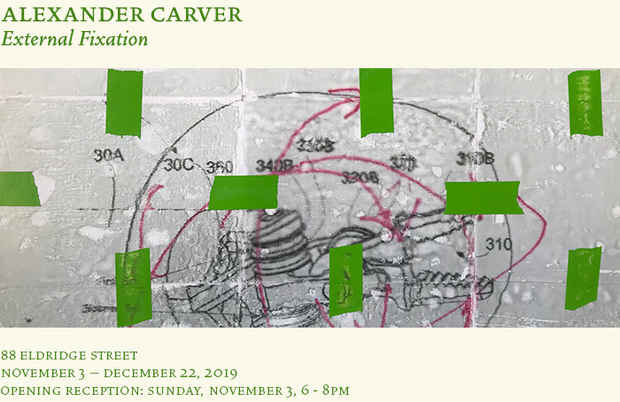Alexander Carver “External Fixation”
Miguel Abreu Gallery (88 Eldridge St.)

This event has ended.
Miguel Abreu Gallery presents External Fixation, Alexander Carver’s first solo exhibition at the gallery.
Surgery is barbaric. The intensity of surgery is often measured by the relative openness of the body cavity during the procedure. “Open” procedures, as they are called, are inherently more traumatic on the body. By contrast, through the use of hyper-articulable micro-instrumentation (laparoscopic, endoscopic, and robotic), minimally invasive surgery deploys a variety of methodologies that circumvent the previous necessity to incise the body. In the case of certain extreme injuries, such as shattered bones, the setting of a fractured limb may be aided by a metal structure – known as external fixation– in order to properly heal. Penetrating through the body’s soft tissue and affixing bone fragments by a threaded end, surgical rods hold the shards in the correct composition.
Painting as a primitive form of cultural technology is abundant with all too-exploited analogies for the body and its viscera. Often, invoking such a metaphor, contemporary painting is described through anthropomorphic terms such as zombie or cadaver. These may be adequate terms for the suspension of the medium, analogically speaking, between autopsy and undead animism. If the pseudo-problems of painting were anthropomorphized would they be symptoms of an ailment?
The indirect address of the canvas in these works is meant to parallel the contradictions of bodily intervention in modern surgery. Through frottage with oil, an indexical but allusive glimpse of creased membranes and woven fabric is rendered in paint on the surface. The woven support of the canvas appears throughout the work as painterly viscera in the form of floating screens and fetid, bile-colored forms that defy classification. Lines cut by hand and machine both create space, anchor form to the picture plane compositionally, and also cancel themselves as painterly gestures. Near trompe l’oeil marks of paint masquerade informally both as pieces of acid- green tape and neon-blue vinyl stencils (a material used in the production of the paintings). Conversely, images of bone and fat produced by the most advanced x-ray imaging technology are translated to canvas by a gelatinous transfer process alongside robotic surgical instruments whose patents have recently expired.
— Alexander Carver
Media
Schedule
from November 03, 2019 to December 22, 2019